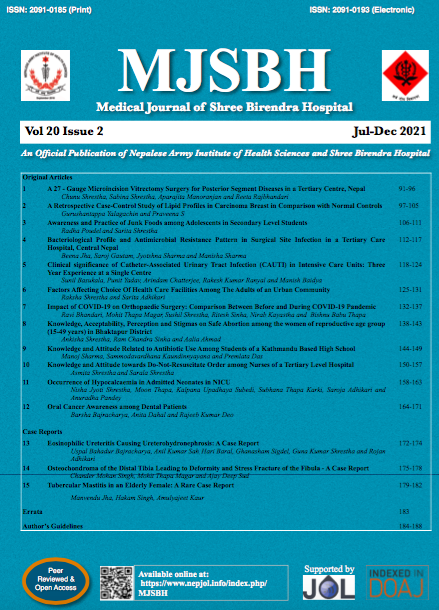A 27 - Gauge Microincision Vitrectomy Surgery for Posterior Segment Diseases in a Tertiary Centre, Nepal
Keywords:
27 guage vitrectomy, micro incision vitrectomy surgery (MIVS), small guage vitrectomy, vitreoretinal surgeryAbstract
Introduction: Transconjunctival micro incision vitrectomy surgery (MIVS) with 23 or 25 gauge instrumentation is more advantageous than traditional 20 gauge surgery. We intended to evaluate the visual outcome, complications and indication of various vitreoretinal diseases using 27 Gauge vitrectomy systems.
Methods: This study was a prospective, interventional, non-comparative study conducted in Nepal Eye Hospital from June 2017 to July 2018. Fifty-two patients with various vitreoretinal diseases were recruited. The main outcome measures included corrected distance visual acuity (CDVA) preoperative and postoperative, intraocular pressure (IOP) preoperative and postoperative, indication for vitreoretinal surgery, intraoperative complications, and postoperative complications.
Results: Fifty two eyes of 52 patients (26 men and 26 women; mean age, 59 years) underwent 27-gauge pars planavitrectomy. Surgical indications included epiretinal membrane (n = 11), full-thickness macular hole (n = 11), rhegmatogenous retinal detachment [n = 14 (12 vitrectomy only and two vitrectomy with scleral buckle)], vitreous haemorrhage (n = 3), vitreous opacities (n = 3), silicon oil removal (n = 3), proliferative diabetic retinopathy [n = 6 (5 vitreous haemorrhage and one tractional retinal detachment)], posterior IOL dislocation (n = 1). Postoperative complications included transient ocular hypertension in eight eyes (15.39%), transient hypotony in five eyes (9.62%) and vitreous haemorrhage in five eyes (9.62%). No cases of postoperative endophthalmitis, sclerotomy - related tears, or choroidal detachments were encountered in the follow-up period. Mean corrected distance visual acuity improved from 20 / 796 (logarithm of the minimum angle of resolution, 1.60 ± 0.64) preoperatively to 20 / 49 (logarithm of the minimum angle of resolution, 0.42 ± 0.26) postoperatively (p = 0.000,) at final follow up.
Conclusions: 27-gauge micro-incision vitrectomy surgery was found to be a safe and effective suture-less surgery with favourable outcomes, in terms of vision.
Downloads
Downloads
Published
How to Cite
Issue
Section
License
Copyright (c) 2021 Medical Journal of Shree Birendra Hospital

This work is licensed under a Creative Commons Attribution-NonCommercial-NoDerivatives 4.0 International License.
This license enables reusers to distribute, remix, adapt, and build upon the material in any medium or format for noncommercial purposes only, and only so long as attribution is given to the creator.




